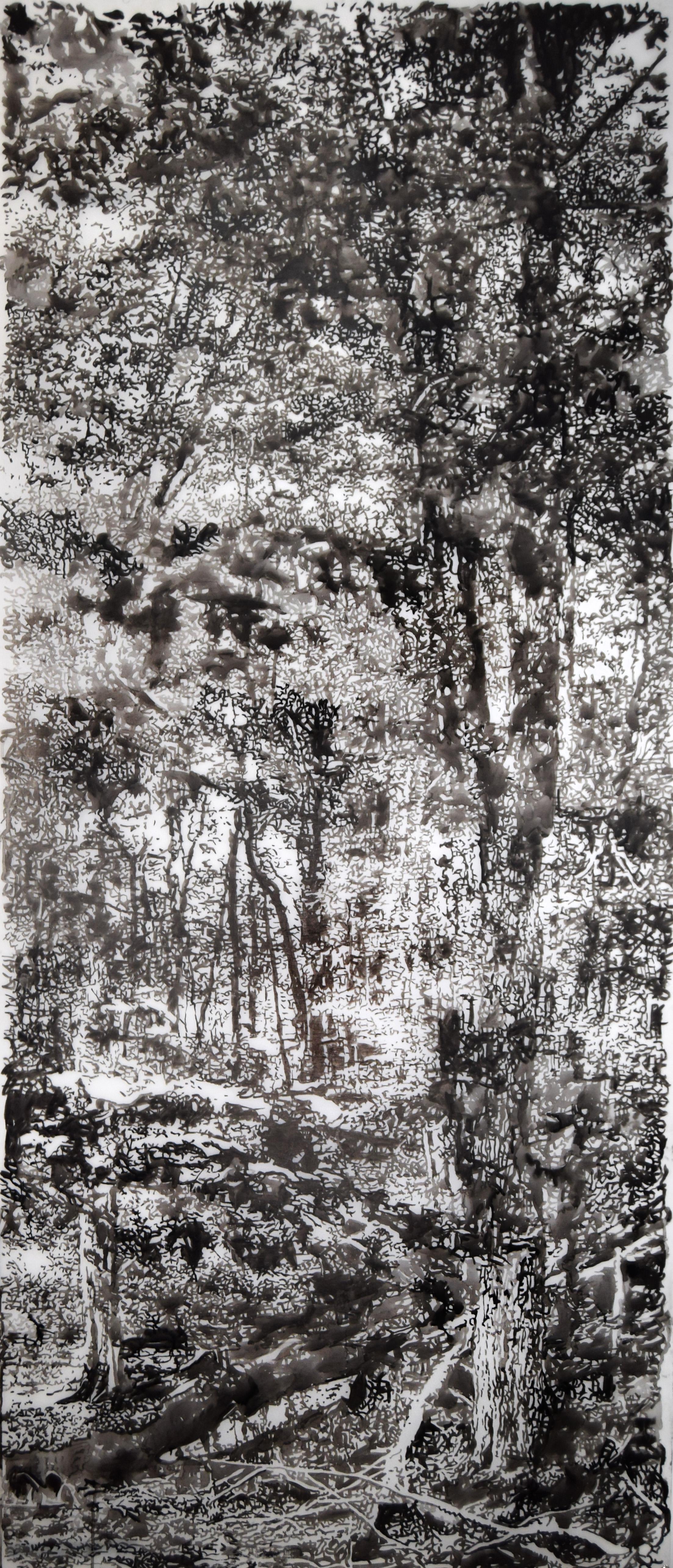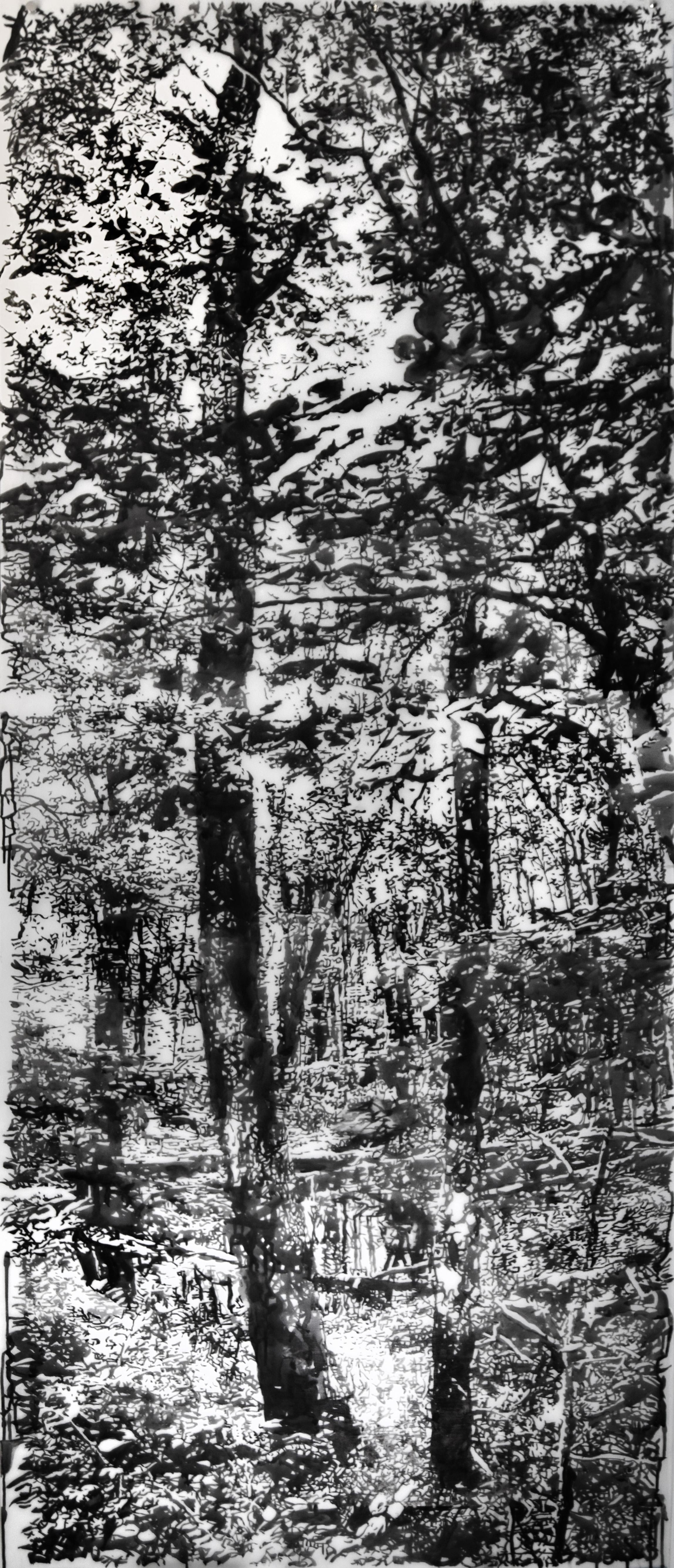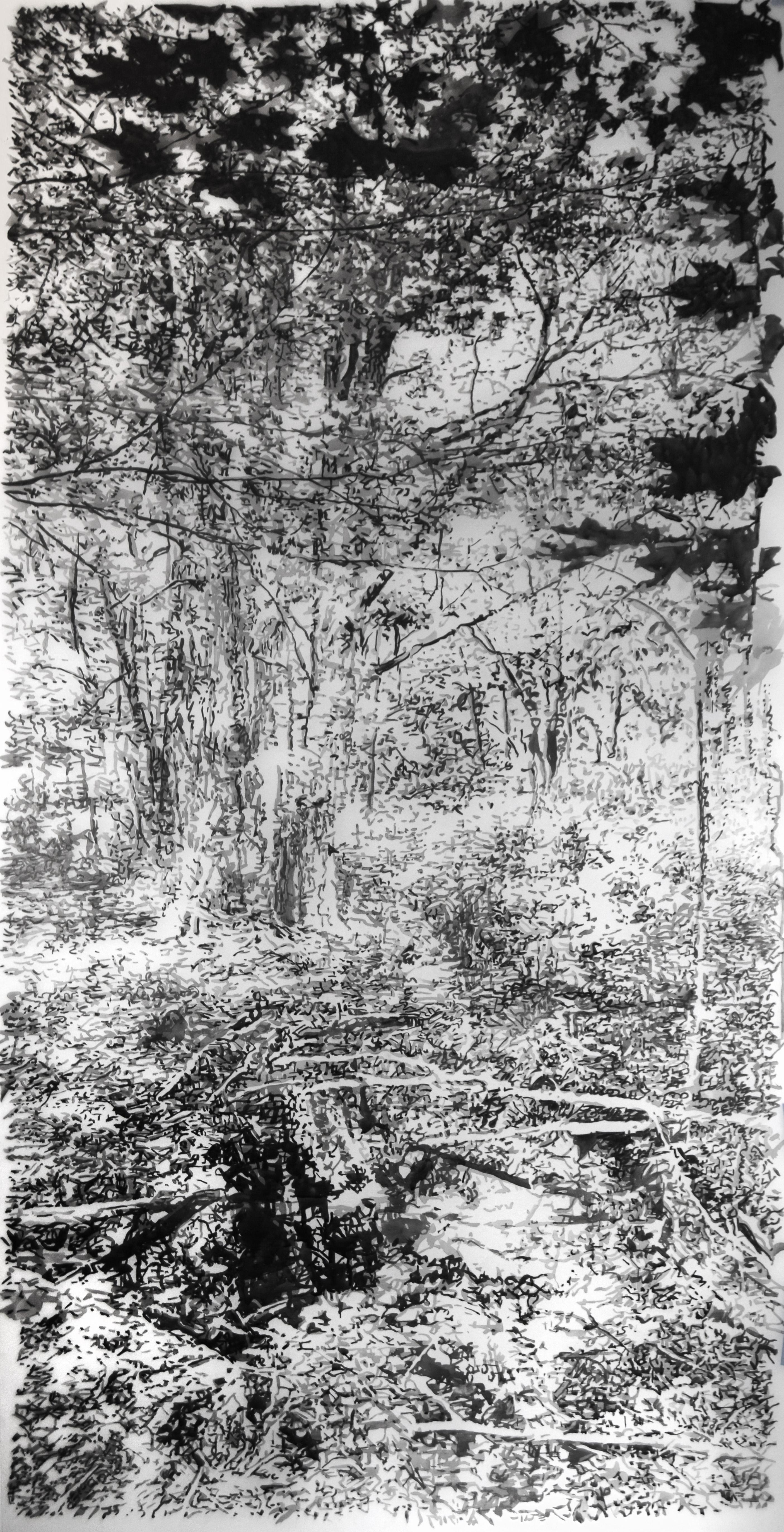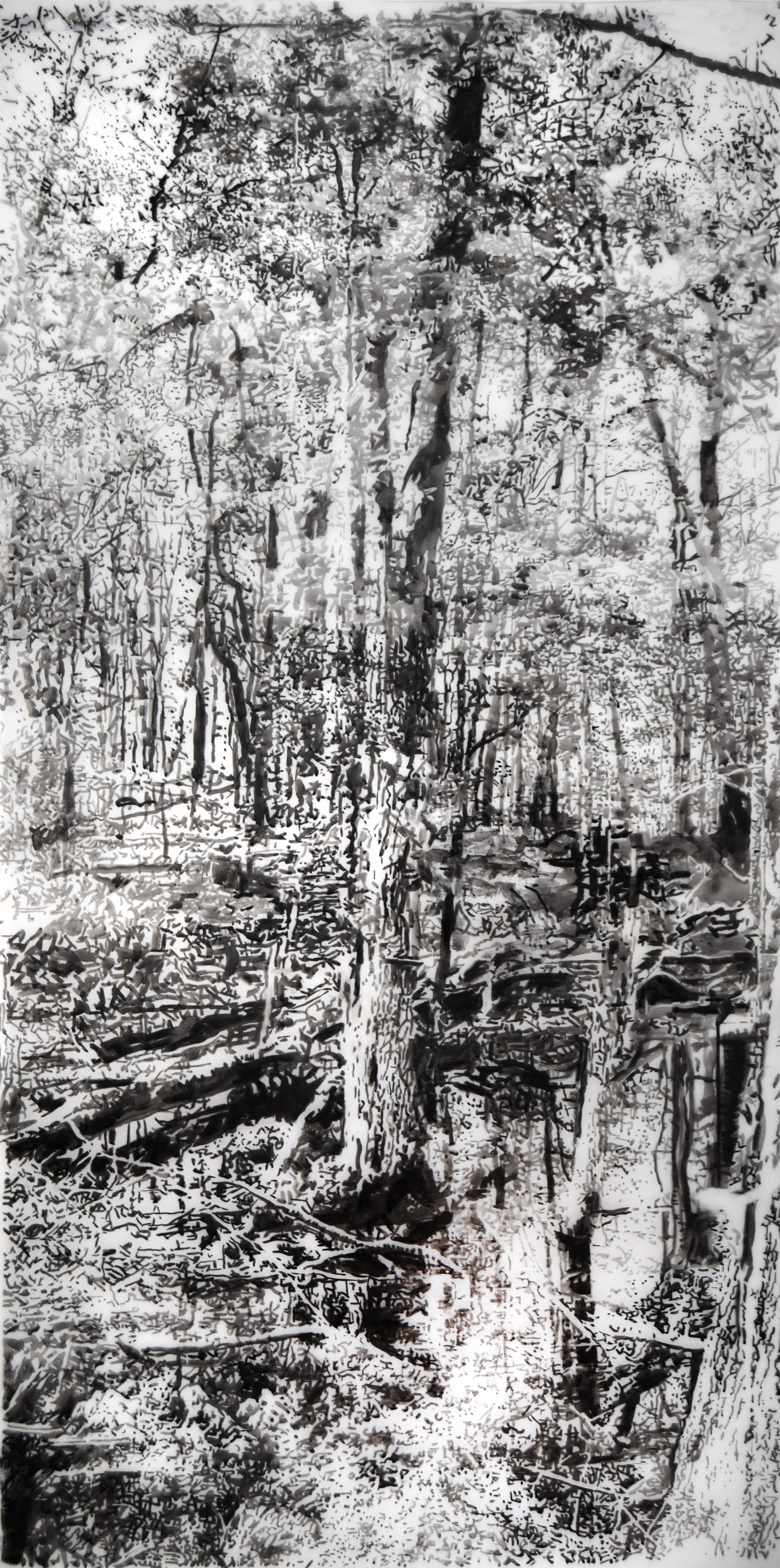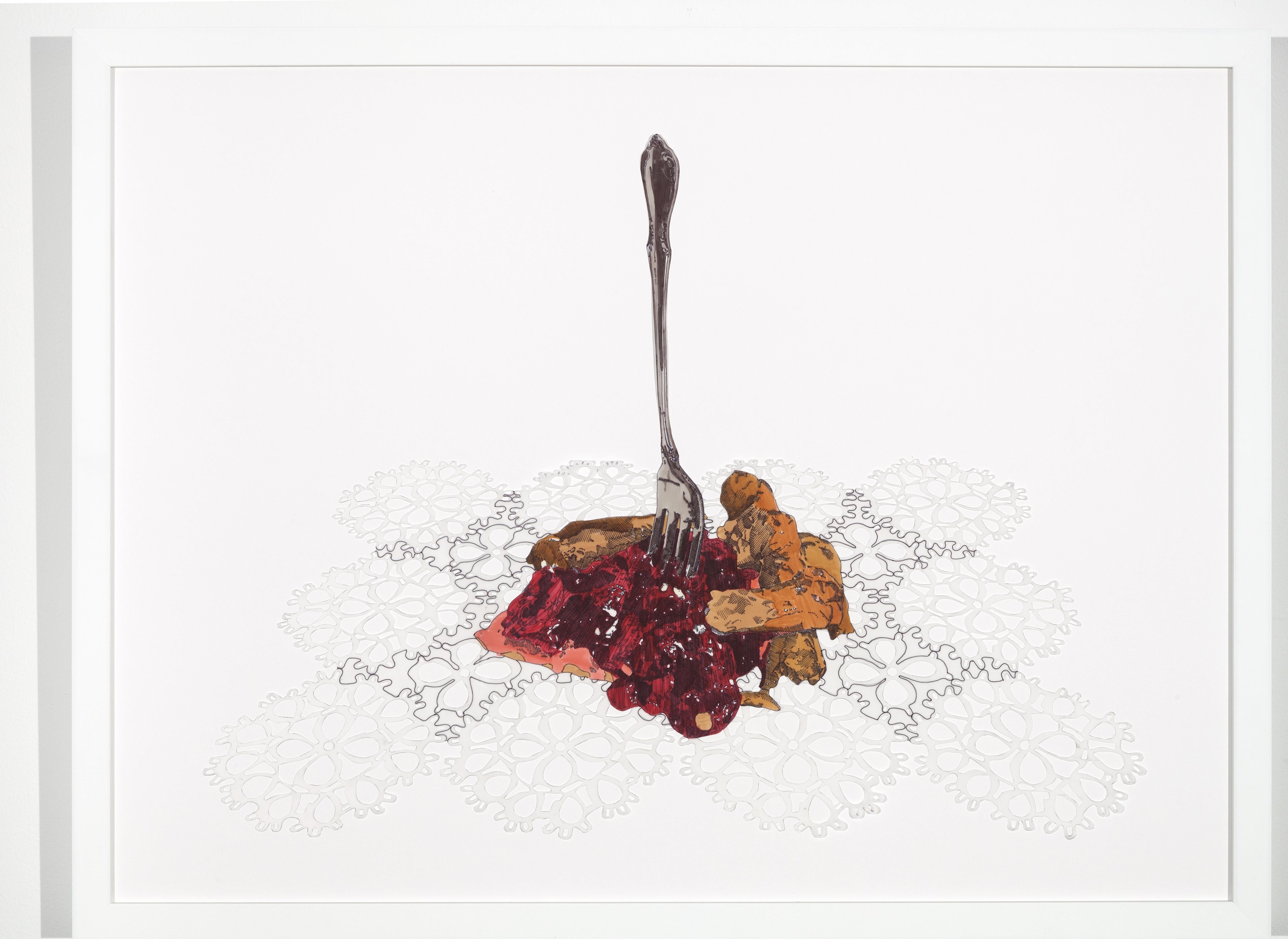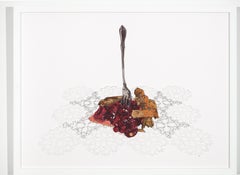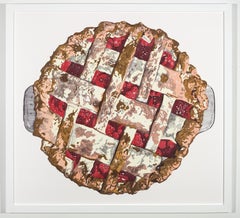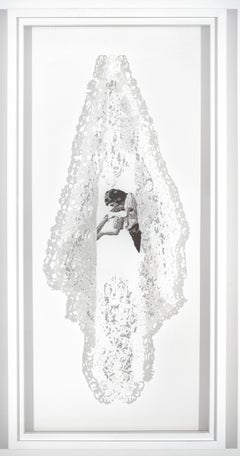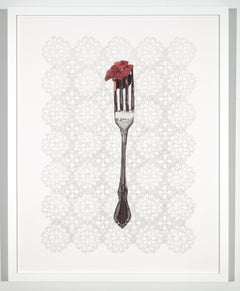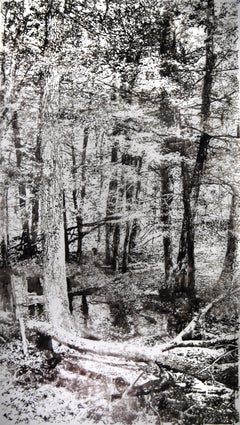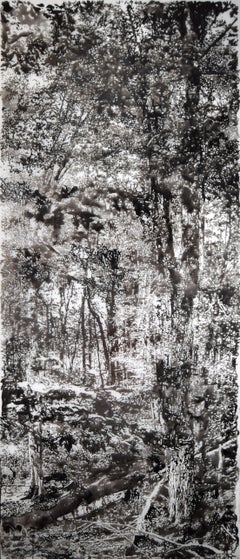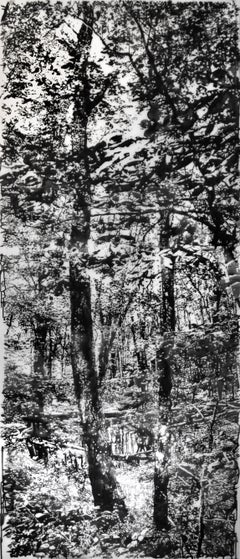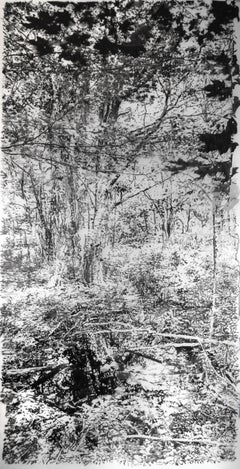Items Similar to Three Tier
Want more images or videos?
Request additional images or videos from the seller
1 of 8
Laura Tanner GrahamThree Tier2021
2021
About the Item
LAURA TANNER GRAHAM’s drawings and installations are often discussed as part of the Southern Gothic literary tradition, sharing similar themes with authors such as Flannery O’Connor and Eudora Welty. As a Georgia native, Graham’s work seeks to understand the ways in which pattern and printed textiles are informed by social and political movements. Her narratives are tightly bound to antebellum traditions while balancing the changing ideals of the new generation of southern society.
Graham received her MFA from the University of Illinois at Urbana-Champaign and a BFA from Florida State University. She has exhibited nationally in both group and solo exhibitions including the Weatherspoon Art Museum, the Ogden Museum of Southern Art, and the Athens Institute of Contemporary Art. She has also been a visiting artist at Tulane University and Valdosta State University. In 2016, Graham was awarded a fellowship and residency at the Ucross Foundation and the Vermont Studio Center. Graham is currently living and making work in Tucson, AZ.
STATEMENT
Firmly grounded in America’s expansive colonial history, my work interrogates how Southern culture has been idealized as “quintessential America” and the bedrock of traditional American values. Using my familiarity and position within Southern culture, I have created a new visual literacy to demonstrate how America’s nostalgia for tradition has been manipulated in an effort to isolate and disenfranchise. My drawings act as a visual archive of research that examines the consequences of American colonialism and addresses the sense of white fragility that continues to pervade Western culture. In the midst of widespread anxiety over the collective American identity, there has been a revival of many of the country’s unresolved historical battles, including contentious race relations, sexism, nativism, and an ever-growing wage gap. I employ the Americana aesthetic of the old South to parallel historical and contemporary acts of resistance to racial, economic, and gender diversity. Borrowing directly from the decorative arts, the meticulously hand-cut mylar and equally intricate drawing capitalizes on America’s propensity for nostalgia to lure the viewer into confronting injustices through the detached lens of that which has already happened.
Through a combination of appropriated and invented imagery, my work contextually constructs contemporary accounts of systemic marginalization, executed under the guise of leisure, embellishment and luxury. The dense visual language invites investigation into the textured surfaces and leads the viewer to reflect on the social textures of contemporary culture while questioning their own complicity in current social constructs. Sourcing from period- specific textiles, turn-of-the-century advertisements, campaign posters, and found family photographs, the collaged images create a singular narrative composition that document the cyclical and systemic nature of marginalization in America. The methodology with which the drawings are constructed echoes historical layers of rules, regulations and hierarchies that are stitched into dominant white American myths. The resulting drawings are indexical in nature, recording the parallels between topics of current debate and 18th century Western expansionism.
The disconnect between the delicate nature of the work and the unresolved cultural tensions that it reveals provides a visual record of the inconsistencies of American idealism. My current project explores the South as the embodiment of America’s pastoral traditions and values that are at the center of the “Make America Great Again” movement, a movement which has both exploited and is at odds with a social ideal that simultaneously proclaims itself to be “post- racial” and “post- gender” while identifying with a “pull-yourself-up-by-the-boot-straps” mentality. As one of the earliest colonized areas, the South is often portrayed as a region of racial and gender stability in the face of impending change. I am currently working with research institutions in the South to further understand how the architectural structure of the Southern plantation helped to build the current social structure of America.
- Creator:Laura Tanner Graham (1987, American)
- Creation Year:2021
- Dimensions:Height: 47.75 in (121.29 cm)Width: 37.25 in (94.62 cm)
- Medium:
- Movement & Style:
- Period:
- Condition:
- Gallery Location:New Orleans, LA
- Reference Number:1stDibs: LU105211899132
About the Seller
5.0
Platinum Seller
Premium sellers with a 4.7+ rating and 24-hour response times
Established in 1998
1stDibs seller since 2015
171 sales on 1stDibs
Typical response time: <1 hour
- ShippingRetrieving quote...Shipping from: New Orleans, LA
- Return Policy
Authenticity Guarantee
In the unlikely event there’s an issue with an item’s authenticity, contact us within 1 year for a full refund. DetailsMoney-Back Guarantee
If your item is not as described, is damaged in transit, or does not arrive, contact us within 7 days for a full refund. Details24-Hour Cancellation
You have a 24-hour grace period in which to reconsider your purchase, with no questions asked.Vetted Professional Sellers
Our world-class sellers must adhere to strict standards for service and quality, maintaining the integrity of our listings.Price-Match Guarantee
If you find that a seller listed the same item for a lower price elsewhere, we’ll match it.Trusted Global Delivery
Our best-in-class carrier network provides specialized shipping options worldwide, including custom delivery.More From This Seller
View AllP.O.P. (Piece of Pie)
By Laura Tanner Graham
Located in New Orleans, LA
artwork dimensions (unframed): 15h x 20w inches
LAURA TANNER GRAHAM’s drawings and installations are often discussed as part of the Southern Gothic literary tradition, sharing similar themes with authors such as Flannery O’Connor and Eudora Welty. As a Georgia native, Graham’s work seeks to understand the ways in which pattern and printed textiles are informed by social and political movements. Her narratives are tightly bound to antebellum traditions while balancing the changing ideals of the new generation of southern society.
Graham received her MFA from the University of Illinois at Urbana-Champaign and a BFA from Florida State University. She has exhibited nationally in both group and solo exhibitions including the Weatherspoon Art Museum, the Ogden Museum of Southern Art, and the Athens Institute of Contemporary Art. She has also been a visiting artist at Tulane University and Valdosta State University. In 2016, Graham was awarded a fellowship and residency at the Ucross Foundation and the Vermont Studio Center. Graham is currently living and making work in Tucson, AZ.
STATEMENT
Firmly grounded in America’s expansive colonial history, my work interrogates how Southern culture has been idealized as “quintessential America” and the bedrock of traditional American values. Using my familiarity and position within Southern culture, I have created a new visual literacy to demonstrate how America’s nostalgia for tradition has been manipulated in an effort to isolate and disenfranchise. My drawings act as a visual archive of research that examines the consequences of American colonialism and addresses the sense of white fragility that continues to pervade Western culture. In the midst of widespread anxiety over the collective American identity, there has been a revival of many of the country’s unresolved historical battles, including contentious race relations, sexism, nativism, and an ever-growing wage gap. I employ the Americana aesthetic of the old South to parallel historical and contemporary acts of resistance to racial, economic, and gender diversity. Borrowing directly from the decorative arts, the meticulously hand-cut mylar and equally intricate drawing capitalizes on America’s propensity for nostalgia to lure the viewer into confronting injustices through the detached lens of that which has already happened.
Through a combination of appropriated and invented imagery, my work contextually constructs contemporary accounts of systemic marginalization, executed under the guise of leisure, embellishment and luxury. The dense visual language invites investigation into the textured surfaces and leads the viewer to reflect on the social textures of contemporary culture while questioning their own complicity in current social constructs. Sourcing from period- specific textiles, turn-of-the-century advertisements, campaign posters, and found family photographs, the collaged images create a singular narrative composition that document the cyclical and systemic nature of marginalization in America. The methodology with which the drawings are constructed echoes historical layers of rules, regulations and hierarchies that are stitched into dominant white American myths. The resulting drawings are indexical in nature, recording the parallels between topics of current debate and 18th century Western expansionism.
The disconnect between the delicate nature of the work and the unresolved cultural tensions that it reveals provides a visual record of the inconsistencies of American idealism. My current project explores the South as the embodiment of America’s pastoral traditions and values that are at the center of the “Make America Great Again” movement, a movement which has both exploited and is at odds with a social ideal that simultaneously proclaims itself to be “post- racial” and “post- gender” while identifying with a “pull-yourself-up-by-the-boot-straps” mentality. As one of the earliest colonized areas, the South is often portrayed as a region of racial and gender stability in the face of impending change. I am currently working with research institutions in the South to further understand how the architectural structure of the Southern plantation...
Category
21st Century and Contemporary Contemporary Drawings and Watercolor Paint...
Materials
Ink, Mylar
The Whole Pie
By Laura Tanner Graham
Located in New Orleans, LA
artwork dimensions (unframed): 35.5h x 39w inches
LAURA TANNER GRAHAM’s drawings and installations are often discussed as part of the Southern Gothic literary tradition, sharing similar themes with authors such as Flannery O’Connor and Eudora Welty. As a Georgia native, Graham’s work seeks to understand the ways in which pattern and printed textiles are informed by social and political movements. Her narratives are tightly bound to antebellum traditions while balancing the changing ideals of the new generation of southern society.
Graham received her MFA from the University of Illinois at Urbana-Champaign and a BFA from Florida State University. She has exhibited nationally in both group and solo exhibitions including the Weatherspoon Art Museum, the Ogden Museum of Southern Art, and the Athens Institute of Contemporary Art. She has also been a visiting artist at Tulane University and Valdosta State University. In 2016, Graham was awarded a fellowship and residency at the Ucross Foundation and the Vermont Studio Center. Graham is currently living and making work in Tucson, AZ.
STATEMENT
Firmly grounded in America’s expansive colonial history, my work interrogates how Southern culture has been idealized as “quintessential America” and the bedrock of traditional American values. Using my familiarity and position within Southern culture, I have created a new visual literacy to demonstrate how America’s nostalgia for tradition has been manipulated in an effort to isolate and disenfranchise. My drawings act as a visual archive of research that examines the consequences of American colonialism and addresses the sense of white fragility that continues to pervade Western culture. In the midst of widespread anxiety over the collective American identity, there has been a revival of many of the country’s unresolved historical battles, including contentious race relations, sexism, nativism, and an ever-growing wage gap. I employ the Americana aesthetic of the old South to parallel historical and contemporary acts of resistance to racial, economic, and gender diversity. Borrowing directly from the decorative arts, the meticulously hand-cut mylar and equally intricate drawing capitalizes on America’s propensity for nostalgia to lure the viewer into confronting injustices through the detached lens of that which has already happened.
Through a combination of appropriated and invented imagery, my work contextually constructs contemporary accounts of systemic marginalization, executed under the guise of leisure, embellishment and luxury. The dense visual language invites investigation into the textured surfaces and leads the viewer to reflect on the social textures of contemporary culture while questioning their own complicity in current social constructs. Sourcing from period- specific textiles, turn-of-the-century advertisements, campaign posters, and found family photographs, the collaged images create a singular narrative composition that document the cyclical and systemic nature of marginalization in America. The methodology with which the drawings are constructed echoes historical layers of rules, regulations and hierarchies that are stitched into dominant white American myths. The resulting drawings are indexical in nature, recording the parallels between topics of current debate and 18th century Western expansionism.
The disconnect between the delicate nature of the work and the unresolved cultural tensions that it reveals provides a visual record of the inconsistencies of American idealism. My current project explores the South as the embodiment of America’s pastoral traditions and values that are at the center of the “Make America Great Again” movement, a movement which has both exploited and is at odds with a social ideal that simultaneously proclaims itself to be “post- racial” and “post- gender” while identifying with a “pull-yourself-up-by-the-boot-straps” mentality. As one of the earliest colonized areas, the South is often portrayed as a region of racial and gender stability in the face of impending change. I am currently working with research institutions in the South to further understand how the architectural structure of the Southern plantation...
Category
21st Century and Contemporary Contemporary Drawings and Watercolor Paint...
Materials
Ink, Mylar
Dead Eye #2
By Laura Tanner Graham
Located in New Orleans, LA
artwork dimensions (unframed): 37.5h x 13.5w inches
Laura Tanner Graham's drawings and installations are often discussed as part of the Southern Gothic literary tradition, sharing s...
Category
21st Century and Contemporary Contemporary Drawings and Watercolor Paint...
Materials
Ink, Mylar
Cherry / Silver / Lace
By Laura Tanner Graham
Located in New Orleans, LA
artwork dimensions (unframed): 20h x 14w inches
LAURA TANNER GRAHAM’s drawings and installations are often discussed as part of the Southern Gothic literary tradition, sharing similar themes with authors such as Flannery O’Connor and Eudora Welty. As a Georgia native, Graham’s work seeks to understand the ways in which pattern and printed textiles are informed by social and political movements. Her narratives are tightly bound to antebellum traditions while balancing the changing ideals of the new generation of southern society.
Graham received her MFA from the University of Illinois at Urbana-Champaign and a BFA from Florida State University. She has exhibited nationally in both group and solo exhibitions including the Weatherspoon Art Museum, the Ogden Museum of Southern Art, and the Athens Institute of Contemporary Art. She has also been a visiting artist at Tulane University and Valdosta State University. In 2016, Graham was awarded a fellowship and residency at the Ucross Foundation and the Vermont Studio Center. Graham is currently living and making work in Tucson, AZ.
STATEMENT
Firmly grounded in America’s expansive colonial history, my work interrogates how Southern culture has been idealized as “quintessential America” and the bedrock of traditional American values. Using my familiarity and position within Southern culture, I have created a new visual literacy to demonstrate how America’s nostalgia for tradition has been manipulated in an effort to isolate and disenfranchise. My drawings act as a visual archive of research that examines the consequences of American colonialism and addresses the sense of white fragility that continues to pervade Western culture. In the midst of widespread anxiety over the collective American identity, there has been a revival of many of the country’s unresolved historical battles, including contentious race relations, sexism, nativism, and an ever-growing wage gap. I employ the Americana aesthetic of the old South to parallel historical and contemporary acts of resistance to racial, economic, and gender diversity. Borrowing directly from the decorative arts, the meticulously hand-cut mylar and equally intricate drawing capitalizes on America’s propensity for nostalgia to lure the viewer into confronting injustices through the detached lens of that which has already happened.
Through a combination of appropriated and invented imagery, my work contextually constructs contemporary accounts of systemic marginalization, executed under the guise of leisure, embellishment and luxury. The dense visual language invites investigation into the textured surfaces and leads the viewer to reflect on the social textures of contemporary culture while questioning their own complicity in current social constructs. Sourcing from period- specific textiles, turn-of-the-century advertisements, campaign posters, and found family photographs, the collaged images create a singular narrative composition that document the cyclical and systemic nature of marginalization in America. The methodology with which the drawings are constructed echoes historical layers of rules, regulations and hierarchies that are stitched into dominant white American myths. The resulting drawings are indexical in nature, recording the parallels between topics of current debate and 18th century Western expansionism.
The disconnect between the delicate nature of the work and the unresolved cultural tensions that it reveals provides a visual record of the inconsistencies of American idealism. My current project explores the South as the embodiment of America’s pastoral traditions and values that are at the center of the “Make America Great Again” movement, a movement which has both exploited and is at odds with a social ideal that simultaneously proclaims itself to be “post- racial” and “post- gender” while identifying with a “pull-yourself-up-by-the-boot-straps” mentality. As one of the earliest colonized areas, the South is often portrayed as a region of racial and gender stability in the face of impending change. I am currently working with research institutions in the South to further understand how the architectural structure of the Southern plantation...
Category
21st Century and Contemporary Contemporary Drawings and Watercolor Paint...
Materials
Ink, Mylar
Dead Eye #1
By Laura Tanner Graham
Located in New Orleans, LA
artwork dimensions (unframed): 37.5h x 13.5w inches
Laura Tanner Graham's drawings and installations are often discussed as part of the Southern Gothic literary tradition, sharing s...
Category
21st Century and Contemporary Contemporary Drawings and Watercolor Paint...
Materials
Mylar, Ink
Natural Lure
By Laura Tanner Graham
Located in New Orleans, LA
LAURA TANNER GRAHAM’s drawings and installations are often discussed as part of the Southern Gothic literary tradition, sharing similar themes with authors such as Flannery O’Connor and Eudora Welty. As a Georgia native, Graham’s work seeks to understand the ways in which pattern and printed textiles are informed by social and political movements. Her narratives are tightly bound to antebellum traditions while balancing the changing ideals of the new generation of southern society.
Graham received her MFA from the University of Illinois at Urbana-Champaign and a BFA from Florida State University. She has exhibited nationally in both group and solo exhibitions including the Weatherspoon Art Museum, the Ogden Museum of Southern Art, and the Athens Institute of Contemporary Art. She has also been a visiting artist at Tulane University and Valdosta State University. In 2016, Graham was awarded a fellowship and residency at the Ucross Foundation and the Vermont Studio Center. Graham is currently living and making work in Tucson, AZ.
STATEMENT
Firmly grounded in America’s expansive colonial history, my work interrogates how Southern culture has been idealized as “quintessential America” and the bedrock of traditional American values. Using my familiarity and position within Southern culture, I have created a new visual literacy to demonstrate how America’s nostalgia for tradition has been manipulated in an effort to isolate and disenfranchise. My drawings act as a visual archive of research that examines the consequences of American colonialism and addresses the sense of white fragility that continues to pervade Western culture. In the midst of widespread anxiety over the collective American identity, there has been a revival of many of the country’s unresolved historical battles, including contentious race relations, sexism, nativism, and an ever-growing wage gap. I employ the Americana aesthetic of the old South to parallel historical and contemporary acts of resistance to racial, economic, and gender diversity. Borrowing directly from the decorative arts, the meticulously hand-cut mylar and equally intricate drawing capitalizes on America’s propensity for nostalgia to lure the viewer into confronting injustices through the detached lens of that which has already happened.
Through a combination of appropriated and invented imagery, my work contextually constructs contemporary accounts of systemic marginalization, executed under the guise of leisure, embellishment and luxury. The dense visual language invites investigation into the textured surfaces and leads the viewer to reflect on the social textures of contemporary culture while questioning their own complicity in current social constructs. Sourcing from period- specific textiles, turn-of-the-century advertisements, campaign posters, and found family photographs, the collaged images create a singular narrative composition that document the cyclical and systemic nature of marginalization in America. The methodology with which the drawings are constructed echoes historical layers of rules, regulations and hierarchies that are stitched into dominant white American myths. The resulting drawings are indexical in nature, recording the parallels between topics of current debate and 18th century Western expansionism.
The disconnect between the delicate nature of the work and the unresolved cultural tensions that it reveals provides a visual record of the inconsistencies of American idealism. My current project explores the South as the embodiment of America’s pastoral traditions and values that are at the center of the “Make America Great Again” movement, a movement which has both exploited and is at odds with a social ideal that simultaneously proclaims itself to be “post- racial” and “post- gender” while identifying with a “pull-yourself-up-by-the-boot-straps” mentality. As one of the earliest colonized areas, the South is often portrayed as a region of racial and gender stability in the face of impending change. I am currently working with research institutions in the South to further understand how the architectural structure of the Southern plantation...
Category
21st Century and Contemporary Contemporary Drawings and Watercolor Paint...
Materials
Mylar, Ink
You May Also Like
Fallen Logs - Forest Landscape Black Sumi Ink White Mylar, 2024
By Andrea Kantrowitz
Located in Kent, CT
In this contemporary landscape in black sumi ink on Mylar, a peaceful forest scene is intricately detailed, beautifully capturing the serenity of a walk in the woods.
This ink drawi...
Category
2010s Contemporary Landscape Drawings and Watercolors
Materials
Mylar, Sumi Ink
Vernal Pool Three - Forest Landscape Black Sumi Ink White Mylar, 2024
By Andrea Kantrowitz
Located in Kent, CT
In this contemporary landscape in black sumi ink on Mylar, a peaceful forest scene is intricately detailed, beautifully capturing the serenity of a walk in the woods.
This ink drawi...
Category
2010s Contemporary Landscape Drawings and Watercolors
Materials
Mylar, Sumi Ink
Two Trees - Forest Landscape Black Sumi Ink White Mylar, 2024
By Andrea Kantrowitz
Located in Kent, CT
In this contemporary landscape in black sumi ink on Mylar, a peaceful forest scene is intricately detailed, beautifully capturing the serenity of a walk in the woods.
This ink drawi...
Category
2010s Contemporary Landscape Drawings and Watercolors
Materials
Mylar, Sumi Ink
Big Tree - Forest Landscape Black Sumi Ink White Mylar, 2024
By Andrea Kantrowitz
Located in Kent, CT
In this contemporary landscape in black sumi ink on Mylar, a peaceful forest scene is intricately detailed, beautifully capturing the serenity of a walk in the woods.
This ink drawi...
Category
2010s Contemporary Landscape Drawings and Watercolors
Materials
Mylar, Sumi Ink
Vernal Pool Two - Forest Landscape Black Sumi Ink White Mylar, 2024
By Andrea Kantrowitz
Located in Kent, CT
In this contemporary landscape in black sumi ink on Mylar, a peaceful forest scene is intricately detailed, beautifully capturing the serenity of a walk in the woods.
This ink drawi...
Category
2010s Contemporary Landscape Drawings and Watercolors
Materials
Mylar, Sumi Ink
Anonymous Self Portrait LIV
By Anthony Goicolea
Located in New York, NY
Ink, graphite, and oil paint on double-sided frosted Mylar film mounted to board
Signed and dated on label, verso
This artwork is offered by ClampArt, located in New York City.
Cub...
Category
2010s Contemporary Mixed Media
Materials
Graphite, Ink, Mylar, Oil, Board
Recently Viewed
View AllMore Ways To Browse
Architecture Hand Drawings
American Pastoral
Framed Drawing Race
Plantation Painting
Old Plantation
18th Century Pastoral Painting
18th Century Colonial Paintings
Colonial Revival American
Eudora Welty
Southern Gothic
Race Relations
Flannery Artist
Laura Battle
Figure Watercolor
Watercolor Society Painting
Tree Drawing
British Watercolour
Drawing Of Trees

